I was back at the car first. It was still raining but nothing too terrible. Suddenly, within seconds of getting into the car, the skies opened up and it began to pour beyond belief. I saw Regan emerge from the building and began to run to the car. Unfortunately in his panic to keep dry, his "left-side drive" instincts kicked in and he ran up to my side of the car thinking it was the passenger side. Like a deer caught in the headlights, he just stood there looking at me, confused as to why I was there. Then the realization of which country he was in took effect and he ran back to his side (the ACTUAL passenger side) of the car... a bit wetter than desired.

The pouring rain at the showers
We made our way out of the park, past small groups of bison, dripping wet in the pouring rain. One near the side of the road was greedily drinking up the water runoff.... quite loudly!

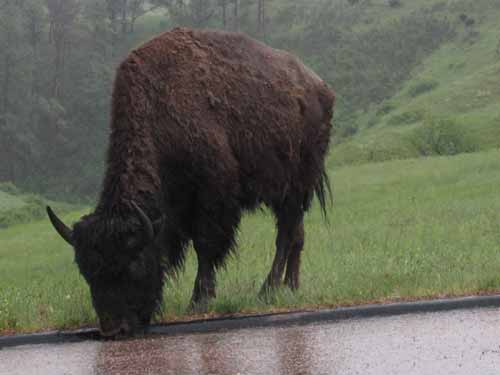
We pulled into the town of Hot Springs. It was too early to go to the museum, so we had some breakfast at Dale's Family Restaurant.... the only place open at that hour. It wasn't the best quality of food, with very greasy eggs and condiments full of high fructose corn syrup.... but it was fun. They served things like "Cowboy Coffee" and the place was filled with morning regulars who called the wait staff by name. Even Dale himself took a turn at the cash register.



Regan 'enjoys' a traditional American breakfast of steak and eggs.
Eventually it was almost time for the Mammoth Site to open, so we settled up and headed on our way.
26,000 years ago, giant mammoths (the ancestors of today's elephants) roamed this area. In 1974, this large sinkhole was discovered that contained the remains of many mammoths and other prehistoric animals.

A long path to the center, marked with giant mammoth tracks, was lined with signs that allowed us to be sort of like time travelers. Starting with the first life on earth, it carried us up to the time of the great beasts whose remains we were about to see. Rocks that corresponded to that time were also on display.

A mammoth-sized footprint... hmmm... it's got the bison beat!

In the beginning...

Schist, pegmatite and granite
Millions of years ago, this area was a vast plain. At times, the seas invaded and covered the land with successive layers of limestone, sandstone and shale. When exposed, the land received deposits left by erosion. Eventually about 7,500 feet of flat layers of rock were collected. Today, 2.5 billion years of rock history tell the story of the area.
Rock types are determined by their texture, composition and the way they were formed:
Igneous rock - formed by the cooling and solidification of magma or lava. They record periods of crustal activity that relate to the movements of the continents.
Metamorphic rock - made deep in the earth's crust, where pre-existing rocks are subjected to such high temperatures and pressures that the minerals in them change. They indicate times of mountain building.
Sedimentary rock - formed on the surface from the accumulation of materials deposited by water, wind or glaciers. They hold information about climate and past organisms.
Shale - often deposited in shallow seas. Because it is soft and made of clay, it weathers quickly when exposed.
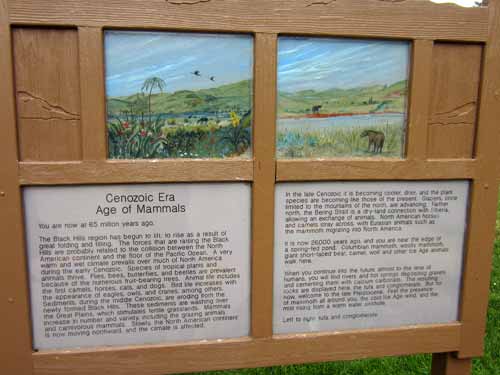
The age of mammals
We signed up for the guided tour. Since it was the first of the day, we were the only ones on it. We first watched a movie about how the area and the sinkhole were formed.
Limestone deposits beneath the earth's surface dissolved in water from underground springs. The land eventually collapsed and the resulting sinkhole filled with 95 degree F water that lured mammoths to drink or feed on vegetation. Once in the water, they couldn't climb back out the steep, slippery edges. Death by starvation or drowning was their inevitable fate. Sediments continued to wash into the pond and bury the bones. This process continued for 300 to 700 years.

The formation of the sinkhole
As the centuries passed, the water table lowered and the spring became inactive. The sinkhole gradually filled in and no longer trapped animals. Instead, they left only footprints in the sediment. Rain, snow and wind deposited soil that created a hill of buried skeletons. It remained that way until excavation for a housing project revealed the incredible find.

Then Ashley led us around the large pit, explaining things as we went. We could then spend as much time as we wanted looking around before moving on to the rest of the museum.
Most of the sinkhole was covered by a tall building. This was to preserve the exposed bones. Originally before the structure was built, the pit had to be refilled each winter since the bones are very fragile. Excavation is only done about 6 week out of the year in summer. This unearths enough fossils that it takes the rest of the year to preserve, identify, sort and catalog them.
The 200 x 100 foot sinkhole is believed to be at least 67 feet deep. Only 22 feet down has been uncovered so far. 60 mammoths have been uncovered so far and it is unknown how many still remain buried. Unfortunately since they aren't petrified, the bones are about the same density as the surrounding rock so they wouldn't show up in a scan.

The ceiling is where the top of the original hill used to be. This is the deep side of the sinkhole...

... and this is the shallow end. The whole place had a very dusty smell to it.

While it might seem like this deathtrap had animals falling into it every day, there were plenty who drank and ate at the water's edge and didn't fall in. On average, probably only 10 fell in per year... over several hundred years.

The teeth are the best way to the species and age of an animal. A mammoth has four teeth. As the animal grows, the teeth get pushed out and replaced by larger ones (not all in one tooth as we do, but ridge by ridge, like a conveyer belt from the back). They get a total of 6 sets: by age 6, they've had three sets; by age 13, they get thir fourth set; the fifth by 27 years; and the last by 43. By age 70, the last set of molars have worn away and, if the mammoth isn't killed by other causes, it basically starves to death from a reduced ability to feed.

So far there have been 57 Columbian mammoths and 3 Woolly mammoths uncovered. The Columbians were the largest of all the species and could eat 500 pounds of vegetation per day.

86 different species have been found, including antelope, wolves, rabbits, coyotes, camels, big-headed llamas (now extinct) and the giant short-faced bear (skull cast pictured above). Other fossils, such as snail shells, indicate that the pool had to be warm because those species couldn't have survived in cold water.

Teeth and tusks

Some of the bones are darker in color. This is due to a preservative that was placed on them to keep them from drying out and cracking before the building was built.

The pit had very defined edges to it, based on the different rock types.

The bones...
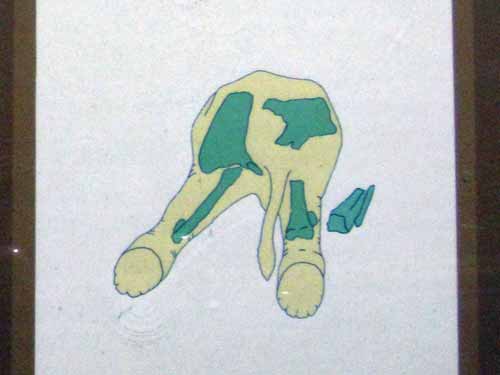
... and the drawing. Only the lower half of this animal was found near the wall. Perhaps it died of exhaustion while trying to climb out and scavangers cleaned up anything they could reach of the front end.

Several of the other animals were much more intact. All but one of them were young males between the ages of 13 - 26 years. The other one was a slightly older male of 47 years (they could live up to 80 years old). Why no females? The theory is that the young males are kicked out of the herd to make their own way. They therefore don't have the wisdom of the herd to guide them away from dangers.

A jumbles of bones. All of the collagen and DNA are gone, having been leeched away by the warm water.
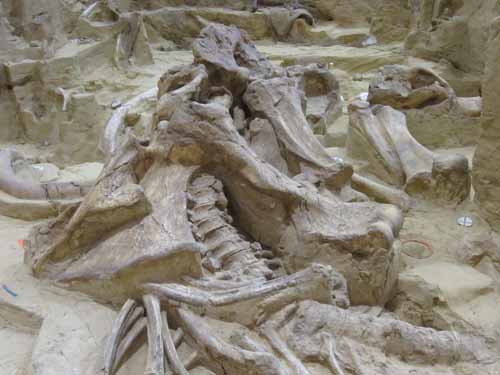
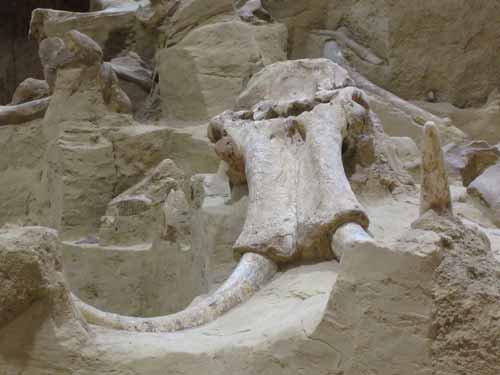

There were three different but gradual episodes of sedimentations filling in the sinkhole over a period of about 750 years. The color striations indicates periods of storms and calm.

Footsteps in the mud

The Columbian mammoth, the African elephant, The Woolly mammoth, the Asian elephant, the Pygmy mammoth, and a miniscule human

Oh how cute! Can we get one?? Pleeeeeease!

It goes by fancy names such as coprolites and rejectamenta, but it's all just crap... literally. It's also kind of scary to think that mammoth dung can still be around after 11,600 years.

The longest tusk found here was 11 feet long, although tusks reaching 13 feet have been found elsewhere.
Tusks are basically enlarged, modified incisor teeth. They are used for defense, food acquisition and competition among members. Tusks grow from the base, making the tip the oldest part. They can also be used as a record of climate, not unlike the rings of a tree.
Unfortunately, like elephant tusks, mammoth tusks are made of ivory and fall prey to black market dealings. In Siberia, the natives frequently encountered preserved mammoths on their hunting trips. Once they discovered the worth of the tusks, they became "tusk hunters," conducting large expeditions. The ruthless quests for only the tusks did considerable damage to the integrity of the the rest of the remains, often leaving them unearthed and exposed, leading to quick decay. The tusks are then hacked up and smuggled to unknown destinations in the Far East.
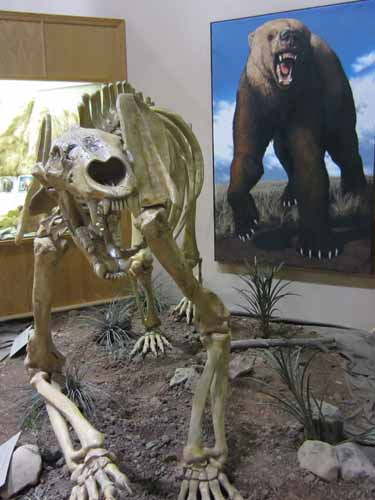
Not only does it look terrifying, but it can do EVERYTHING better than you can... it can run 40 - 50 miles per hour, stands 5'10" at the shoulder, and can look into a second story window on its hind legs.


Mammoth bone houses have been found in the plains of the Ukraine, Poland and the Czech Republic and are around 12,000 - 19,000 years old. These were semi-permanent base camps following the migration paths of the animals they hunted.

Some of the larger huts used up to 149 mammoth jaws.

Why did the mammoths disappear about 11,000 years ago? The debate of "overchill vs overkill" still goes on. Were they hunted to extinction or were they unable to adapt to the drastic climate changes at the end of the Pleistocene (like the ground sloths, horses and saber-toothed cats in North America)?

The atlatl was used prior to the invention of the bow and arrow. It is a "spear thrower" that is basically an extension of the arm, allowing greater distance and velocity of the spear.

Mastodons (mammut) were not closely related to mammoths (mammuthus).

